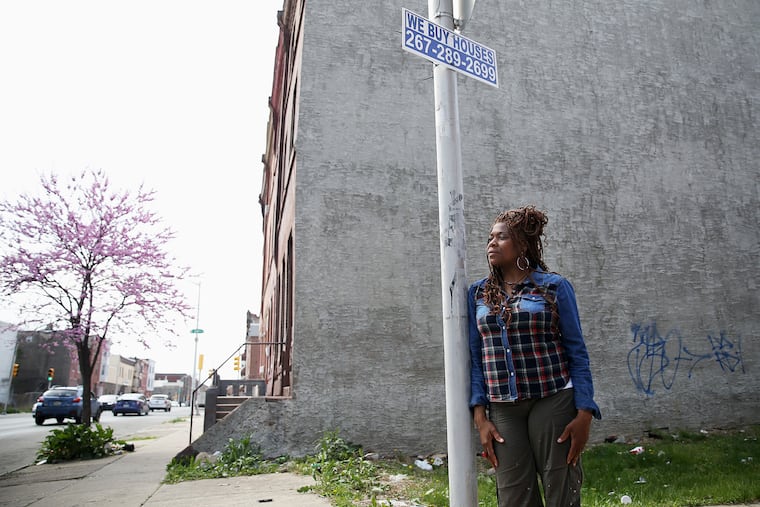Unflinching hope in the Philly neighborhood that the most people have abandoned | Mike Newall
Twenty percent of Strawberry Mansion's population left. But that tells just part of the story.

Kevin Upshur is one of the ones who stayed.
He planted his flag at the corner of 30th and Dauphin Streets in the heart of Strawberry Mansion, which has lost the highest percentage of its population of anywhere else in the city since 2000. But Upshur never thought of leaving.
There’s so much to be done here, in a neighborhood that shoulders what can feel like every grim statistic the city measures. Upshur, 58, is the head of the Strawberry Mansion Community Learning Center — the prime after-school spot, housed in what was once his family’s corner bar.
“I enjoy having an opportunity to put this puzzle back together,” said Upshur, a soft-spoken man with a runner’s build and a trim salt-and-pepper beard.
And he knows what the puzzle looked like before it was shattered: when there were jobs, and people who would hire from the neighborhood. When the houses that line 30th and Dauphin were full.
As neighborhoods in Center City and South Philly — and even neighborhoods close to Strawberry Mansion — have boomed with new arrivals, the recently released Pew “State of the City” report put this community at the bottom of so many lists. It lost 20 percent of its population between 2000 and 2017. Its police district has the second-highest number of violent crimes, behind only one in North Philadelphia. It has the lowest median home sale price: $20,000.
“The contrast between the struggling and thriving neighborhood is as dramatic as ever,” said Larry Eichel, a project director at Pew, who recently wrote about 10 years of Pew reports on the city — ones that tell a depressing story of rising inequity.
Unequal Growth Trends in Philadelphia
Strawberry Mansion's 19132 zip code lost 20 percent of its residents since 2000, the highest rate of loss among Philadelphia's zip codes. Two other zip codes, 19106 (Old City) and 19123 (Northern Liberties), grew by at least 50 percent.
The state of Strawberry Mansion is on full display at 30th and Dauphin. Yes, there are the markers that every outsider uses to define a neighborhood by its despair: Abandoned lots. Abandoned houses. Strawberry Mansion High School, built for 1,800 students, which now has only 169. For a year, my colleagues Kristen Graham and Tim Tai have been following students, teachers, and parents as they struggle to keep the proud old school’s doors open.
But then you have Upshur’s haven of a learning center, with the college banners (Ohio State, Minnesota, Oklahoma) hanging on the wall, the fully stocked library (Dreams of My Father, biographies of Spike Lee and civil rights leaders) and Upshur continually hammering home his mantra: In a neighborhood where opportunities can feel scarce, you can still create your own.
The report isn’t wrong, he says. It just shows only part of the story. “The reality and the energy in this community is another thing,” he said.
Across the street, at the Strawberry Mansion Auto Repair, that pride and energy are carried by Cougar Dancey and Curtis Richardson. They echoed a refrain common among so many living outside Center City’s progress: Strawberry Mansion makes the news only when something bad happens.
The auto shop is a 42-year-old institution; Richardson and every one of his brothers has worked here. Greg Blocker inherited the shop from his father, James “Pops” Blocker — an icon in the community, and another who stayed, whose businesses provide stability. For all of them, Strawberry Mansion isn’t a place to escape. It’s a place to be proud of. It’s a sentiment we’d do well to remember.
“My family is still here. My job. My friends,” Dancey said. “I have moved to other areas of the city. Didn’t feel right. I moved back.”
And as progress sweeps toward Strawberry Mansion, those who have tended the flame have to be part of it.
That’s why Tonnetta Graham keeps a map in her office that shows the tide of gentrification coming up from Brewerytown and Center City. Graham, the head of the Strawberry Mansion Community Development Corporation, tells neighbors they used to be up to their ankles in gentrification, and now they’re up to their knees. There are “We Buy Houses for Cash” signs plastering every pole, and handwritten ones in people’s mailboxes. She encourages people to hang on — to be part of the progress.
They won’t drown in the wave of gentrification, she’s certain, and cites a good statistic: Nearly half the residents own their own homes. It’s Graham’s job to make sure those voices are at the table when change comes.
“We’ve always known that our neighborhood is a treasure — Fairmount Park is my backyard,” she said. “Our transportation is fantabulous. The housing stock is so beautiful — you still see the workmanship, the craftsmanship. And there’s a resiliency to the neighborhood.”
For proof, just stop by 30th and Dauphin.